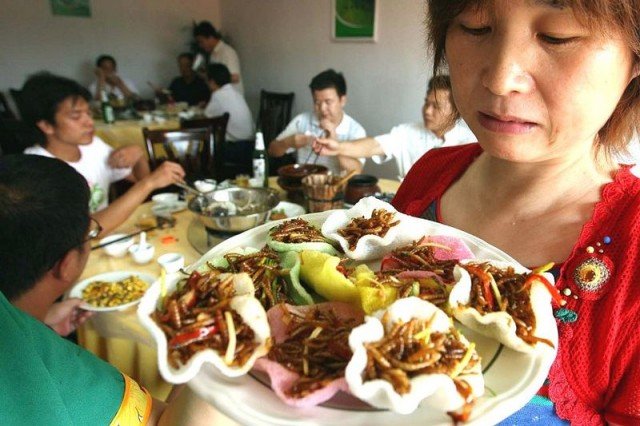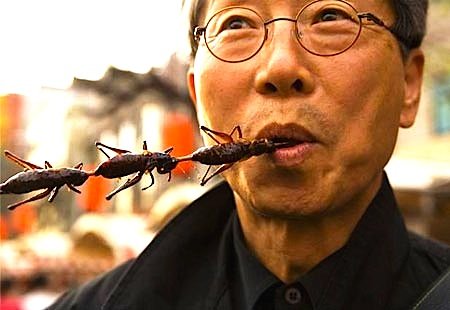According to a new UN report, eating more insects could help fight world hunger.
The report by the UN Food and Agriculture Organization says that eating insects could help boost nutrition and reduce pollution.
It notes than over 2 billion people worldwide already supplement their diet with insects.
However, it admits that “consumer disgust” remains a large barrier in many Western countries.
Wasps, beetles and other insects are currently “underutilized” as food for people and livestock, the report says. Insect farming is “one of the many ways to address food and feed security”.
“Insects are everywhere and they reproduce quickly, and they have high growth and feed conversion rates and a low environmental footprint,” says the report.
The authors point out that insects are nutritious, with high protein, fat and mineral content.
They are “particularly important as a food supplement for undernourished children”.

The report by the UN Food and Agriculture Organization says that eating insects could help boost nutrition and reduce pollution
Insects are also “extremely efficient” in converting feed into edible meat. Crickets, for example, need 12 times less feed than cattle to produce the same amount of protein, according to the report.
Most insects are likely to produce fewer environmentally harmful greenhouse gases than other livestock.
The ammonia emissions associated with insect-rearing are far lower than those linked to conventional livestock such as pigs, says the report.
Insects are regularly eaten by many of the world’s population, but the thought may seem shocking to many Westerners.
The report suggests that the food industry could help in “raising the status of insects” by including them in new recipes and adding them to restaurant menus.
It goes on to note that in some places, certain insects are considered delicacies.
For example some caterpillars in southern Africa are seen as luxuries and command high prices.
Most edible insects are gathered in forests and serve niche markets, the report states.
It calls for improved regulation and production for using insects as feed.
“The use of insects on a large scale as a feed ingredient is technically feasible, and established companies in various parts of the world are already leading the way,” it adds.
[youtube eKRUuGeTOg0]
European Union has decided to spend 3 million Euros to research “the potential of insects as an alternative source of protein”.
EU says that research projects will be selected during this year.
Food experts agree that insects would probably have to be disguised for European audiences, so the insect “food” could be used as an additive in burgers and other fast food.
The UN’s Food Standards Authority says of the research: “While insects have not traditionally been used for food in the UK or elsewhere in the European Union, it is estimated that about 2.5 billion people across the world have diets that routinely include insects.
“While many insects are regarded as pests, the UN’s Food and Agriculture authority is interested in promoting edible insects as a highly sustainable source of nutrition.”
Some worms contain three times as much protein as beef per ounce, while four crickets have as much calcium as a glass of milk.
Daniel Creedon, a chef who serves ants, locusts and bees in honey at the London Archipelago restaurant, said: “If insects start coming into the food chain they are probably going to have to be disguised.
“Food producers will probably get away with describing it as animal based proteins. Not many people will buy a locust burger.”
Website Treehugger said: “It is not hard to imagine the development of an insect-based food additive that enriches burger and nugget protein levels.
“Burgers with processed insect meal could be sold by chains under claims such as <<higher in protein>>, <<healthier fats>> and <<eco-burger>>.”

European Union has decided to spend 3 million Euros to research “the potential of insects as an alternative source of protein”
80% of countries on Earth already eat insects, and more than 2,000 insect species are often eaten by human beings.
Unlike conventional livestock, insects and bugs need little space and can be bred in sealed buildings under natural light where they live off waste, paper and algae.
The idea has previously been backed by the UN and EU as a way to tackle food shortages.
Some academics believe that the expense and environmental cost of raising livestock means that insect-eating will be inevitable – and it has been claimed that by the end of this decade, insect-eating will be widespread.
Prof. Marcel Dicke from Wageningen University in the Netherlands said: “The most important thing is getting people prepared, getting used to the idea. Because from 2020 onwards, there won’t be much of a choice for us.”
An estimated 2,000 insect species are consumed around the world, and people do not just eat insects, they relish them as delicacies. In Africa, caterpillars and winged termites are fried and eaten as roadside snacks (after wings, legs, and bristles are removed, of course), and often considered tastier than meat. Grasshoppers and bee larvae seasoned with soy sauce are favorites in Japan, where pricey canned insects are also available. Papua New Guinea is known for its nutty-flavored sago grubs (Rhynchophorus ferrugineus papuanus or R. bilineatus), beetle larvae that inhabit dead sago palm trees and are honored at annual festivals.
Insects often contain more protein, fat, and carbohydrates than equal amounts of beef or fish, and a higher energy value than soybeans, maize, beef, fish, lentils, or other beans. According to a 2004 United Nations Food and Agriculture Organization (FAO) report, caterpillars of many species are rich in potassium, calcium, magnesium, zinc, and iron, as well as B-vitamins. In some African regions, children fight malnutrition by eating flour made out of dried caterpillars. Pregnant and nursing women as well as anemic people also eat caterpillar species high in protein, calcium, and iron.


